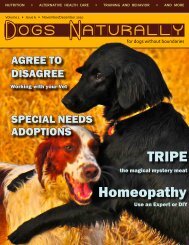July/August 2010 - Dogs Naturally Magazine
July/August 2010 - Dogs Naturally Magazine
July/August 2010 - Dogs Naturally Magazine
Create successful ePaper yourself
Turn your PDF publications into a flip-book with our unique Google optimized e-Paper software.
Part 3 Getting Behavior<br />
<strong>Dogs</strong> are always behaving. Your job as a trainer is to convince<br />
your dog to do the behaviors you like by reinforcing<br />
the behaviors you like. The problem is, you have to get that<br />
behaviour in the first place! Fortunately, there are several<br />
ways to set your dog up to start doing the behaviors you<br />
want, although some are much more effective than others.<br />
© K Delong Photography<br />
Luring<br />
Luring would involve having the dog follow a cookie or toy<br />
in order to produce the behaviour you want. An example of<br />
this would be putting a cookie on his nose to entice him to<br />
sit or holding it up to your face to get eye contact. There are<br />
definite limitations with luring. The first problem is the<br />
timeline: you are putting the reinforcer before the intended<br />
behavior. You learned in Part 1 that consequences drive<br />
behaviour. If you intend to teach your dog to look at you by<br />
luring him with a cookie, then you must be aware of what<br />
he is doing when you pull that cookie out of your pocket<br />
because you will be reinforcing that behavior. This is a<br />
problem with luring: the trainer can inadvertently reward<br />
an unwanted behavior. If your dog looks away and you<br />
then pull out a cookie to lure him to look at your face, you<br />
are rewarding looking away because it is that precise behavior<br />
that makes the cookie appear.<br />
This brings us to the second problem with luring: it rewards<br />
passivity. Clicker trainers love behavior: the more<br />
behaviors a dog can give you, the faster and better we can<br />
teach him which ones you want. Trainers normally bring<br />
out lures when the dog is doing nothing and the dog quickly<br />
learns to do nothing because that is exactly what earns him<br />
reinforcement.<br />
The third problem with luring is that the dog is not actively<br />
involved in the learning process. If you lure the dog into a<br />
sit with a cookie, the dog is not thinking about the sit, he is<br />
thinking about following the cookie. The sit just happens<br />
and there is little learning occurring. Once again, the dog is<br />
passive in the process.<br />
Finally, luring can be very reinforcing for the trainer because<br />
the dog actually does the desired behavior very<br />
quickly. The problem is, you want the dog to learn, not just<br />
behave. The dog will be a lot more reliable if he is actively<br />
learning, not just following cookies.<br />
Prompting<br />
Prompting is similar to luring although you would use body<br />
language to persuade your dog to do the things you<br />
want. You might blow in your dog's face to teach him to<br />
wave or start running to teach him to come when<br />
called. Prompts have the same limitations as lures.<br />
Capturing<br />
Capturing would be waiting for the dog to offer the behavior<br />
himself and reinforcing it when you get it. If you wanted<br />
<strong>Dogs</strong>...<strong>Naturally</strong>! <strong>July</strong>/<strong>August</strong> <strong>2010</strong><br />
by: Dana Scott












